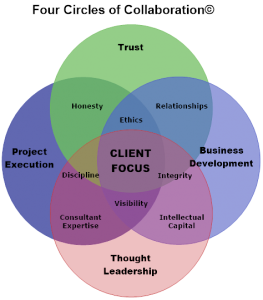Collaboration—An Essential Ingredient for Growth
It is quite common for members of professional groups or associations to look to one another for collegial support, the sharing of best practices and referrals. These interactions are just a few of the myriad of benefits.
But for the most part these interactions are transactional and stand-alone. The interaction happens while each consultant goes about his or her own business. There may be a referral fee exchanged—or perhaps a professional services fee for assistance with a practice challenge such as a web site, IT problem or personal coaching need.
While these interactions are undoubtedly valuable, they rarely result in the kind of fundamental structural change to a practice that enables significant revenue growth. Achieving growth in a practice by increasing the size of client engagements, almost always requires discovering ways to add both capacity and capability—in other words, additional consultants with complementary specialties.
A successful venture into multi-consultant engagements requires a strong collaboration model. In this white-paper we offer our shared experiences and a four-part model.
The Model: The Four Circles of Consultant Collaboration
The Four Circle model is based on two premises. First, for a collaboration model to work, it must provide value to all stakeholders, clients and collaborators—clients first. Secondly, an effective collaboration model must be congruent with the individual collaborators’ success models. In this article we will focus on the first premise.
The model depicted in Figure A posits a framework for a long lasting collaborative arrangement that will support continued practice and client growth. The model creates long-term synergy. It does not come together for a single engagement and then dissolve.
The four components are: a) Trust, b) Business Development, c) Thought Leadership and d) Project Execution. See the figure below

Trust: The Foundation
Mutual trust means an explicit commitment to a common code of ethics and values. This is essential. For us, as management consultants, there is no better starting point than the Institute of Management Consultants (IMC) Code of Ethics.
Our experience is compiled in a Ten Point Trust Checklist and will supplement that “gut-feeling” concerning a potential collaborator. The checklist helps to determine whether you invite this person to work with you and to meet your most valued client based upon a more meaningful and objective criteria than “He or she seems nice”. You owe your client meaningful due diligence when selecting collaborators.
For each item on the checklist, one should ask, “To what degree does this potential collaborator demonstrate…”
Ten Point Trust Checklist
1. Competence: client results, track record, testimonials, project management, case studies, industry expertise, academic accomplishment, thought leadership
2. Primacy of the Client: priorities and value to client; has the best interest of the client at heart at all times
3. Intra-Collaborator Communication: open and honest, tool savvy
4. Collaboration: track record of other successful collaborative projects
5. Discipline: process and project management
6. Documentation: reliable tools and methodologies
7. Client Communication: strong verbal, written and people skills
8. Financial/Business Acumen: linking all activities to the economic benefit of the client
9. Commitment: accountable and dependable
10. Integrity
There are two important trust links that must be solid. The first is between you and your collaborators and the second is between the collaborator and the client.
Regarding interpersonal collaborator trust: trust does not typically happen overnight. Nor does trust grow without continually building and reinforcing the points on the checklist. Remember, it takes years to build trust— only seconds to destroy it.
Regarding client trust: your client is depending on you to select only the best collaborator to work on his or her project. By using the Ten Point Trust Checklist you can clearly articulate why you are making the recommendation you are.
Business Development: Also Known As Making Rain
Anyone desiring a successful practice needs to know how to capture new business. Collaborative projects where one or more of the collaborators simply burn-off project backlog landed by others, do not build effective long-lasting collaborations. Each member of the collaborative team should be actively working to increase the visibility of the group and increase the probability of landing new opportunities. Leaving the rainmaking to everyone else does not build a long term collaborative relationship or trust. No free rides.
Business development is something we as consultants need to do everyday. The challenge is that most of us are trying to balance our time between execution, administration and selling. We typically spend more time in the delivery mode (where we actually use our expertise and do what we enjoy) than in developing new business relationships and opportunities.
Several years ago, Jerry brought on (hired) a collaborator with expertise in organizational management to assist in a two-year corporate turnaround project. It was explicit; collaboration would require business development—not simply execution. After 6 months it was apparent this individual could not, did not want to, and avoided at all costs, engaging in new business development activities. Yet, he was very good at what he did. The client loved him.
The solution: he became available to the client for full-time employment. That deal consummated, he was happier, the client was delighted and Jerry was free to begin work with a new collaborator with a business development gene.
Thought Leadership: A Thoughtleading Frame of Mind
It is generally accepted in the consulting ranks that thoughtleading— publishing, speaking on topics related to original thought, research, individual intellectual capital and work experience demonstrate competence and expertise. If each collaborator in a group is actively engaged in thoughtleading activities such as these, the probability of additional opportunity for collaboration is more likely. A thoughtleading frame of mind can generate greater market exposure and perceived expertise for the group.
Collaborating consultants have a dual responsibility; to their own practice and to their collaborative team to publish and speak. This illustrates the concept of “congruency” mentioned in our second premise.
In productive collaborations, published works and joint presentations as well as shared success stories, help build credibility.
A good example of collaborative thought leading synergy is the book “Absolute Honesty” by Bob Phillips and Larry Johnson. These two individuals, with completely different expertise, worked together to develop a product that is useful to both individual practices. Bob is an Organizational Development specialist and Larry is a motivational speaker. Bob developed the “Straight Talk” workshop which was generated from the book, as a major component of his practice and Larry uses the book’s concepts and principles as a major component of his keynotes.
When Larry asked Bob to collaborate on a book, the common ground for both was honesty and integrity in the workplace. The basis for their collaborative efforts was their personal value system of relating to clients and others with a high standard of integrity and respect.
One can see the “Trust”, “Thought Leadership” and “Business Development” parts of our four circle model at work in this example.
Project Execution
The ultimate determination of success in a collaborative engagement is “delivery” to the client. There must be clear expectations; before, during and after the work is completed.
In a recent collaborative engagement with multiple people, projects and deadlines, Diane found using a project management worksheet was the best tool for managing deliverables. Remember the Gantt chart? Collaborators must discuss in detail and reach consensus on each of the deliverables to avoid jeopardizing the project or a negative impact to the client. Open and honest communication is essential. We suggest five categories around which to achieve collaborative clarity.
Deliverables: The first rule of deliverables—be clear and specific. Be very, very clear and specific. The second rule—never agree to pay a collaborating consultant an hourly fee in a fixed price contract. While it may sound obvious, we won’t mention which author fell prey to this.
Deliverables should be clearly defined, specific and easily identifiable. Here’s a specific example: train 25 sales people in 5 specific locations nationwide. Here’s a non-specific and vague example: improve the productivity of the sales force. And here’s an example that has the potential for trouble: improve the sales force productivity by 30% in the next year. While this last example is specific, it may be difficult to achieve because it is out of the consultant’s span of control. Whether defining deliverables as a standalone consultant, or in a collaborative arrangement, task ownership and expected results must be clear.
Milestones and Checkpoints: If your client proposal does not reference a timeline for deliverables, you may want to consider one. Project management software and templates are plentiful. However, a well-designed Excel spreadsheet may be sufficient for planning, scheduling and monitoring a project.
The timeline identifies various milestones, checkpoints and dependencies of the project. It communicates to the client when the work should be completed. It also helps both client and consultant in scheduling resources, staff, etc. and staying focused on priorities.
Fee Structure: Building a fair revenue sharing model is key to avoiding many issues. If not addressed prior to the launch of a client engagement, a poorly planned fee structure can lead to a quick, one-project, bitter ending to what could have been a potentially great collaborative team.
Table 1 suggests a useful Financial Split Model.
Intellectual Property (IP): Assure that ownership of any IP created in preparation for, during and/or after project completion is clearly defined. Typically, IP agreements are written to cover inventions or techniques that may result from project execution. The basic issue is who owns what and under what conditions.
For example, IP related to the project itself (software developed, designs, tools) typically reverts to the client as work-for-hire outcomes. If a new “tool” is consultancy-practice-related, ownership will revert to the managing consultancy practice as long as specifically understood by the client and collaborators. The tool, from that point on, is owned by the collaborator under whose business entity the project is being executed.
Whatever the circumstance, clarity between all parties is critical.P.S. The last 1% is set aside for the post-execution celebration.
Data Retention: Every step along the way, documents and electronic communication must be managed. It is vital that data created, collected and presented, be retained and maintained. Data and filing systems (paper and electronic) should be easily accessible and well organized. If you or the client need a document during the project or post-project, records should be easy to retrieve.
In one case, the owner of a large firm expressed concern over the value of a major two-year transformation program. The consultant volunteered a comprehensive project audit. Because all project work had been well documented (proposals, work product, deliverables, communications, etc.) the audit turned a stern-faced confrontation to a delighted client experience and supplemental work.
Conclusion
When problems arise in a collaboration, it is usually because details, deliverables, expectations, ownership, fees and accountabilities were not clarified, agreed to, documented and/or signed.
In addition to the contractual specifics of individual projects, it is imperative that collaborators understand and work within a mutually agreed upon and understood framework—a framework that extends beyond a single project to one that creates a long term business relationship.
We have proposed a four-circle collaboration model with crucial and distinct parts: Trust, Business Development, Thought Leadership and Project Execution. Understanding and operating within this framework creates the greatest congruency and synergy for all concerned.
*********
About the authors:
Diane Gibson, is President and Founder of DMG Consultancy, Ltd. an organizational development and change management consulting firm serving clients in Idaho, Washington and Oregon.
Bob Phillips, is a Principal with RW & Associates, Inc. an organizational development consultancy headquartered in Bend, OR specializing in cultural ethics. Bob is co-author of “Absolute Honesty”, now in its 10th printing, and the book’s companion “Straight Talk” workshop.
Jerry Vieira, CMC is President and Founder of The QMP Group, Inc., a Portland, OR. based management consulting firm that assists clients in growing the market value of their businesses through market strategy and marketing & sales organizational transformations.
*******
Click for information about QMP’s Consultancy Navigator Program. Learn how to start and grow your consulting practice and get the coaching you need to make it happen quickly.

